When I was a teenager (admittedly, a long time ago), a 500cc bike was considered a big bike. I thought Honda’s CB350s were fast, and CB450s were really fast. Now, of course, a 500cc bike is hardly considered a “mid-displacement” machine.
Nevertheless, we were pleased to see Honda revive a smaller displacement twin a few years ago, and certainly enjoyed our test of the CBR500R. The precise displacement is 471cc for this fuel injected parallel-twin with four-valve heads. A nice six-speed transmission provides a good range of gearing, as well.
Honda offers this motor in an adventure-style machine, as well. Indeed, the subject of this test is the 2016 CB500X, which has all the prerequisites of the adventure tourer category, including upright ergos, a wind screen and increased suspension travel (5.5″ front and 4.7″ rear).
Perhaps not all the prerequisites of the category, as the CB500X makes do with 17″ wheels both front and rear. Some adventure tourers have 19″ front wheels for better off-road usability (occasionally you can find a 21″ front). Those wheels are shod with Dunlop Trailmax tires sized 120/70 in front and 160/60 out back.
The suspension is non-adjustable with the exception of spring preload on the fork and shock. Like its siblings, the CB500X has a single front brake disc sized 320 mm squeezed by a two-piston caliper, and a smaller 240 mm rear disc with single-piston caliper.
Curb weight (with the 4.6 gallon fuel tank full) is a claimed 427. 6 pounds. Reasonable, but not quite as light as you might expect a 500 twin to be. As we found out, 4.6 gallons provides more than 250 miles of range, even when the bike is ridden aggressively.
The 2016 CB500X is actually the second iteration of the model, which was updated for 2016 with a number of changes. Suspension tuning was changed and adjustable fork preload was added. Additionally, more wind protection comes from a taller screen and lighting improves with LEDs both front and rear. Styling is “sharper” according to Honda, and detail changes include a new muffler design, adjustable front brake lever, improved gear-change feel and a hinged fuel cap.
Riding the CB500X was a very pleasurable experience for a number of reasons. First and foremost, this is an extremely comfortable motorcycle. Invitingly so … if you have several bikes in the garage and are in the mood for a stress-free ride, the CB500X beckons.
For an adventure bike, the seat is also relatively low (31.8″), and lifting it off its side stand and moving it out of the garage couldn’t be much easier.
The power won’t snap your neck back, but it is a nice step up from the current batch of 250s and 300s, both in terms of torque and peak horsepower. The fuel injection is dialed in well and the power spread is wide. Even on the highway at elevated speeds, where the 300s can feel a bit wheezy, the CB500X had plenty of speed and felt relatively relaxed in the 70-80 mph zone.
Fuel economy is also exemplary. It is hard to get less than 55 mpg (even while wringing its neck we achieved this figure), and getting close to 65 mpg is very doable. With 4.6 gallons on tap, the theoretical range of the CB500X is all the way up in 300 mile territory. If you haven’t owned a bike that you can fill up and ride, and ride … and ride without worrying about running out of gas, this is a joy in itself.
Handling is light and predictable, as well as stable at higher speeds. Nevertheless, the first thing we would do to the CB500X is swap out the hard Dunlop semi-knobbys for a pure street tire of good quality. The CB500X deserves this treatment, which would undoubtedly improve both performance and comfort (as well as fuel economy).
Suspension tuning of the largely non-adjustable units is good, although damping of small choppy bumps in front is characteristic of non-cartridge forks. That is, a bit harsh. Other bumps, including undulating surface changes, are handled well. Light off-roading (graded fire trails, for instance) works better than on bigger, heavier bikes, but is not this bike’s strong suit.
The brakes work surprisingly well given their specification. This makes sense given that a similar single front disc set-up is used by Honda on the much heavier NC700X. Both feel and power are more than adequate.
A legible, informative instrument panel, and windscreen adjustable for height, also enhance the comfort and practicality of the CB500X. Even the passenger accommodations are reasonably generous, and several Honda accessories, including luggage, make the CB500X a more than reasonable platform for touring. We did two, 500 mile days on the CB500X.
Indeed, given its heritage, it shouldn’t be surprising that Honda can produce a modern parallel twin of high quality. That is exactly what we have in the CB500X. A bike that is as fun to ride as it is practical and comfortable.
Although we tested a 2016 model and the 2017 version has already been announced, there are no changes whatsoever save color choice . For 2017, the CB500X gets a $100 price bump to an U.S. MSRP of $6,599. The 2017 model is only available in Candy Rose Red. Take a look at Honda’s web site for additional details, specifications and available accessories.
See more of MD’s great photography:
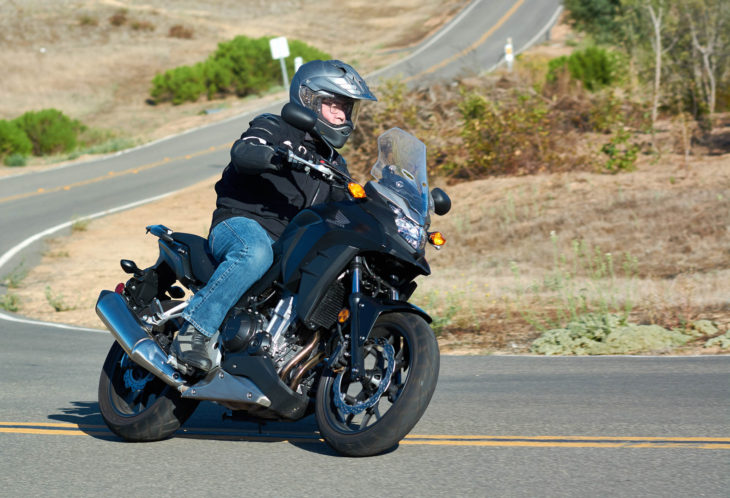
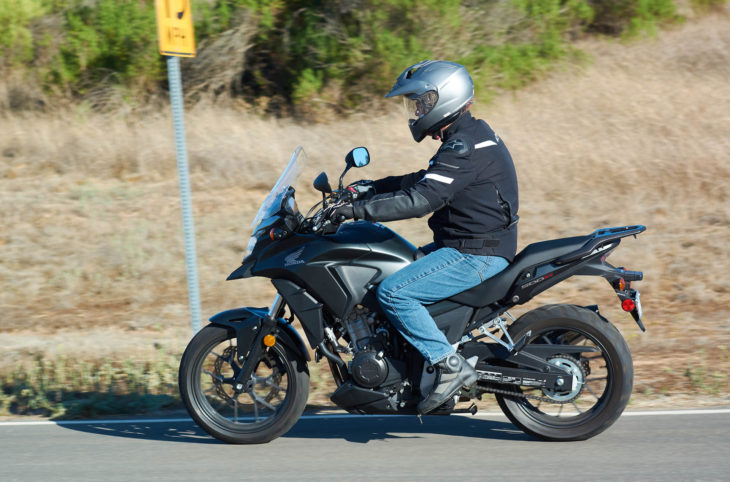
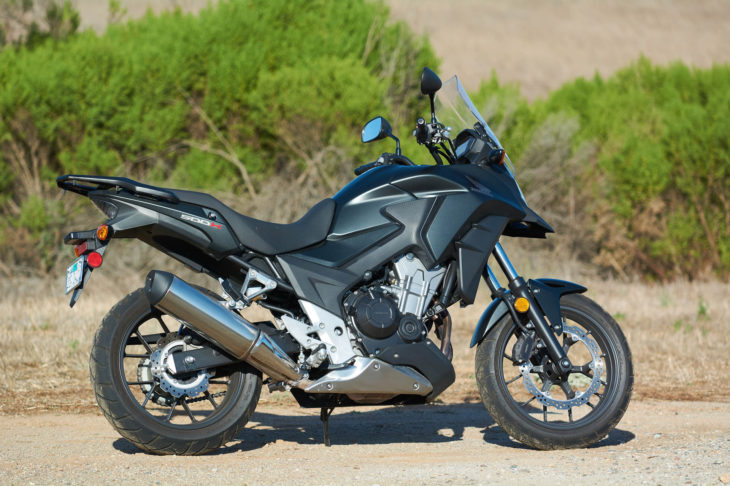
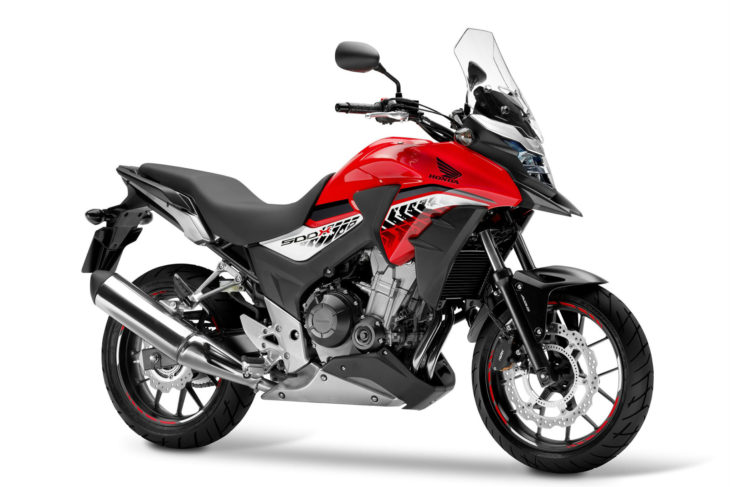
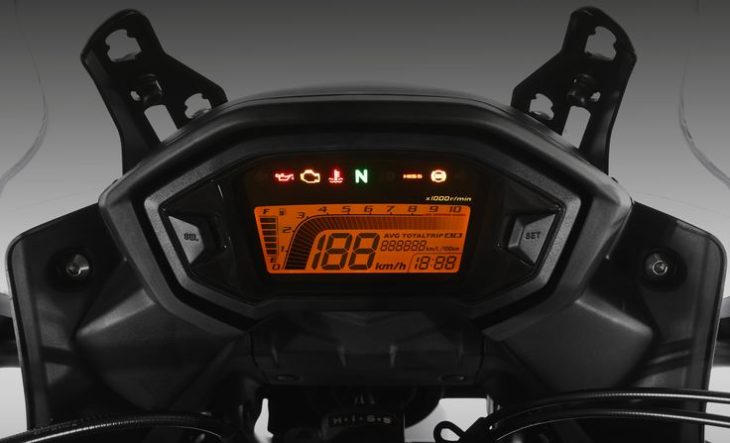
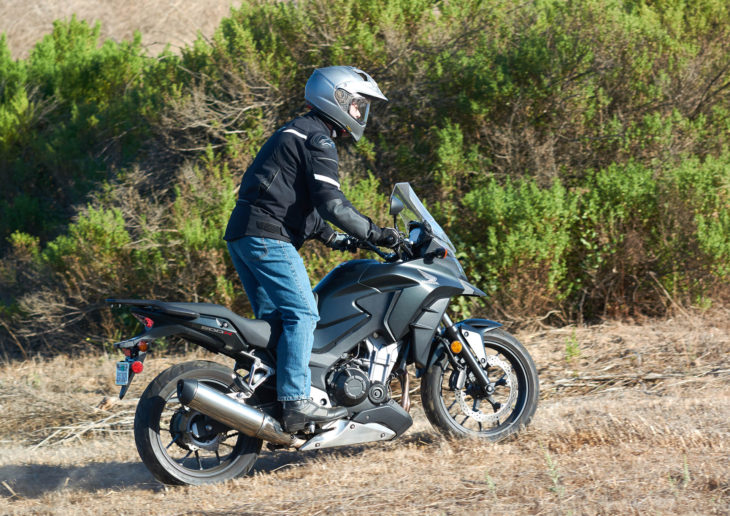






To not include a gear indicator on an entry level bike is really stupid. Sure you can ride without one but you can say that about fuel gauge and some other instrumentation… it would only cost $5 to include it… Typical Honda…
**Correction: The 2017 model actually has the new silencer, not the 2016 which has the same silencer as the 2015. That and a different lower engine cover (or no cover maybe?) are the changes for 2017 besides color. The red for 2017 looks very nice. The 2016 matte sand or black were love or hate really. See for yourself
http://powersports.honda.com/2017/cb500x.aspx
I’m pretty excited for this update. All the 2016 Honda 500 models look so much better, and I love the LED headlights. I’m very much considering getting the 500X to replace my FZ-07 for more comfort, ABS, better fuel economy and range. Sadly I do not think the Yamaha Tracer 700 (FJ-07) will ever be sold here.
Like MD mentioned, new tires are a must! My friend’s 2014 came with Pirelli Scorpion Trail which are basically the same thing as the Dunlop Trailsmart and they both are pretty hard and lack feel/grip. He replaced those with Bridgestone T30evo and those are a revelation on that bike, totally transformed the handling.
I love the bike. I bought the bike new with the intention of installing a Rally Raid Adventure kit. But now I’m not so sure because the bike is just so perfect for me around town. The CB (City Bike) tag really does apply to the 500x. I have a top case installed and constantly ride
it around to run errands, eat, work, whatever! It excels around town! Not sure I want to spoil that.
I had a 2016 out for test ride as well as the 2015 prior. Both feel light and maneuverable and the power of 47 crankshaft hp is fine for those that actually like to ride,shift gears and corner. Meaning it involves you in the actual riding process. Jaded power junkies should look else where. My height being on the shorter side I found a noticeable difference in the shorter 2015 windscreen vs the 16. I was amazed the 15 was so quiet but the 16 produced the same annoying wind blast I get on my current Versys. You’ll also get frustrated trying to ride with roll on throttle jockey types on big torquey bikes. These are the ones that roll on then let off after gaining 40 mph near instantly. They are a pain in the arse to ride with as keeping the 500 on the boil requires a bit of gear shifting and real estate. Suspension and tires seemed near perfect for my 160 weight in stock settings. You Tube raw video at https://www.youtube.com/watch?v=ms46RV8hXZY
re: “Jaded power junkies should look else where.”
camera cuts to scene of Norm scanning horizon with a set of binoculars.
Honda has done an excellent job with this bike. I don’t see the 17″ wheel being a issue for this bike. You have a much greater selection of tires and competitive pricing at 17″. Kawasaki Versys, Yamaha FJ-09 also follow this, among several others. Most ADV bikes will never see much more than a gravel hard packed road. I think factory installed saddlebags should be included for this model. Honda bags will be about $900 in required parts before dealer install. Install the bags, and centerstand on the assembly line, keep the price competitive. I’d guess sales would increase. Riders in the good ol’ USA need to remember we are no longer the largest consumer of motorcycles in this world market.
I’ve owned a ’15 model for about a year and 2,000 miles. Just a great little bike. Light and easy to maneuver; enough power to do freeways without having to wring its neck (and I’m over 225 lbs.); economical; easy to fit the optional centerstand. There’s no massive amount of power, but it’s enough to have fun.
I have a few other, bigger bikes. I keep track of my riding, and the 500X was my most-ridden bike last year (by # of rides, though not mileage). With a Givi topcase and a small tank bag, it’s scooter-like in its practicality for everyday errand-running. Toss on another bag and maybe a bigger windscreen and I wouldn’t hesitate to take it cross-country.
I added the factory handguards (I’d probably go with Givi if I had it to do over) and replaced the muffler with a Delkevic slip-on, just to make it easier to hear what’s going on with the engine. Sounds great now, not loud. For me the 17″ front wheel isn’t an issue; don’t plan to take the bike very far off pavement.
If you told me I could only keep one bike, and that budget was a real concern, no doubt it would be the one I’d hang onto.
I really wonder who’s in charge of Honda color and graphics, at least for the US market. The grayish black pictured on the 2016 test unit is a bit dull, but discreet. And there are no stripes/graphics. The red for 2107 is OK, but the graphics are Excessive, though perhaps not as bad as those on the “sand” colored 500X’s from previous years. I know that “BNG” is an ongoing motorcycle press and forum joke, but does Honda need to fuel the fires any more than they already do with eh the XL650R?
“ADV” bike with a 17″ front wheel? I think not.
There are no good tire choices for off-pavement adventuring in 17″. A feel that a 19″ would be a much better option.
TKC 80’s come in 17 front and that’s plenty knobby for this bike. But yeah, 19 would be better. I think the bigger issue for adventure riding on the cb-x is the short travel/lack of ground clearance suspension.
I really hate those on the pavement.
yep it’s the old dual sport tire dilemma. But is there a true knobby that’s any better? the trailrider/disatanzia/anakee types are not in the same league.
I usually run Shinko 705s – they are good for “off pavement” riding, and a really solid on the street.
I put on a set of DT knobbies for the Idaho Backwoods Discovery Route – not good on pavement, but pretty good in dirt.
The Avan Trailrider is available in 17″. I tried them when they were call the Distanza and liked them.
Agreed, that word gets applied to anything with upright ergos. A 19″ front wheel minimum would make this thing a cool small adventure tourer. The coversion is probably tougher with the low fender though.
Back in the 80’s, my buddy had a Suzuki GS1100 with a 19″ front wheel, and it was terrible offroad.
Well, the rest of that bike would also have something to do with it (I had an ’83). Pavement is its home.
Is it possible to build a smaller bike with a smooth suspension and engine that is not ready for track days but can carry you all day without jolting your spine and give you good passing power. Could it also have adjustable seat height and position and pegs that can be moved? Something that fits you and not you it. Spending an extra 3000 on any bike for seats and suspension isn’t me.
In my fantasy world “smaller” bikes would have an optional “real” suspension package available as an upgrade.
Whoa dude, your fantasy world must be a fantasticAl place, with unicorns aND Hobgoodlins and magical swords mine looks for a value where I don’t invest in a pyramid scheme. Now by upgraded suspension you mean track ready that rattles yer kidneys and wears out your spine we are not talking about the same thing. Although why shouldn’t both be avaiable.
By the way you know what a mugrump is you litarary scoundrel you.
Merry Texas Christmas You all!
Be that as it may BMW will be coming out what with a g 310 gs. The field is getting crowded. I hope it comes with the adjust ability of the 1200gs. Just a fantasy of mine. Seat adjustment of 4 or 5 inches.
I agree with evaluation as far as commonality with previous generation may be concerned. I purchased 2015 model, milder in styling, but otherwise basically same bike. I am satisfied at the utmost. I first thought it is on a heavy side but changed my mind when searching thru history and comparing other models from different makers. I believe the weight comes for good part as result of very strong frame and sub-frame. If some extra weight is in engine area it is also good thing, since it adds to durability and reliability. Its use as “adventure” in my case is reduced to roads with substandard surface, which is adventurous enough for me. This is my 3rd and best Honda so far (the previous one was twice as powerful at about same weight, but still).
Btw, I have on my bike Pirelli Scorpios (first time Pirelli, actually), which work very well. They are kind of semi-road, semi-trail type. In comparison with such brands like Dunlop, Avon, Continental and Metzeler I had on other bikes, they not just stand comparison, but they stand out.
wow Dirck two 500 mile days is a lot more test than you usually get, which is about 100-125 miles isn’t it?
On longer term evaluation models (like this one), we might put that kind of mileage on. You might be thinking of press introductions where you would typically ride with a group for a single day.
It would sure be cool if Honda cooked up some small displacement I-4 bikes like they used to build. Maybe a financial case can’t be made for it, but I would stand in line to buy something like the 250-550cc range I-4s they used to sell.
Those models exist, some friends on Australia for example post the other day a link to the CB400, here is a link I found after a quick duckduckgo search…
http://www.productreview.com.au/p/honda-cb400.html
Price may be the reason why thy don’t bring it to this side of the world.
We’re slowly changing, but the US hasn’t typically rewarded smaller bikes with our purchase dollars. The I4 400’s wew did get were fun but really peaky. That 400 looks really cool, but for even money I’d probably pick the cb650. It’s a milder tune, looks a lot like that 400, and reportedly very good on the street.
People in this forum agree with your point of view. Price is very similar and as you said milder tune could work better.
I’m not sure but it seems there is a minority that would love to have a double R version of that 400 in an even lighter package, the 18,000 RPM CBR250 it’s a common reference.
https://www.reddit.com/r/Honda/comments/4kd5xe/1990_honda_cbr250rr_jdm_imported_bike_4_cylinders/
That photo almost look modern (in my opinion a timeless design).
I hope we get back to a place where small displacement performance bikes (and cars) become popular again. Signs are positive.
From Visordown: ” The CB650F is tiny. It feels like a four-cylinder 400 from the Nineties. That helps make it hugely confidence inspiring and flattering to ride.”
Four cylinder 400’s were never popular in the U.S. Magazines still speak lovingly about the 1975 CB400F, and I still have one in my garage. It’s a wonderful bike. But what no one mentions is that outside of California and a couple of other places in the U.S., it didn’t sell well.
I remember that I went to my local Honda dealer here in the San Francisco Bay Area in 1976, and suddenly he had a showroom full of CB400F’s. Probably 20 or 30. I asked him why he had so many and he said that he purchased them from dealers in other states who couldn’t move them for anything. (He did quickly sell them all. Motorcyclists here loved them.)
About 15 years later Honda offered the CB-1, which was a much updated, water-cooled version. It didn’t even sell well in California.
Riders in the U.S. want a bike that can cruise on the Freeway comfortably for hours. A 400-class bike, even one with four cylinders, isn’t a good choice for this.
IIRC, the same or similar vintage Honda CB400 Hawk twin ran circles around the CB400F in every contest of performance, including among the greatest lean angles of any street bike sold up to then. (I’m quite sure its lean angle is still superb by modern standards. Inline fours suffered from excessive engine width, not corrected till years later when the alternator moved from the crank end to side mounted chain drive).
Plus, the Hawk’s SRP was much lower, and it sipped much less fuel.
Yes, this ignores the four’s appearance, soulful song, and pride of ownership.
It’s interesting to see the street bike market start to embrace the parallel twin in sort of the same way it did with the inline four cylinder in the past. It seems that people are starting to realize that a street bike is more fun if it has street bike level performance. The sport bike market was built on about the same sort of performance as today’s parallel twins. The engines can be four strokes again and not have the sort of fake two stroke power bands that the current open class bikes have. Where they seem to “come on the pipe” at about 6K RPM.
The market “embraced” the parallel twin long before four-cylinder machines were even available. Honda, Yamaha and Suzuki produced a huge assortment of parallel twins, both two-stroke and four-stroke, based on the seminal Bonneville architecture, in sizes ranging from 175 cc up to 650 cc.
Yep, and twins make a lot more sense for a small-to-mid-sized street machine. I can’t quite comprehend those wanting 4 little bottle caps furiously producing hand and foot-numbing high-frequency vibes, while gutless at street speeds (and, with aftermarket pipes, sounding almost as unpleasant as a chain saw). They must be transfixed by the 4 snaking exhaust headers dreaming of 15,000 rpm, and relishing the thought of adjusting 16 valves.
At least it’s available in a color besides primer.
2017 muffler is different and I think it looks better-I had a 2014 for 1.5 years ok bike nothing bad but nothing real good either-now on 2016 Kawasaki 650abs Versys big jump up-the Versys is my 50th bike in 52 years of riding
Rally-Raid makes multiple suspension/protection/wheel Kits for the “X”…….spoked wheels also. You can spend about $3,000 for the RR3 Kit and ride it around the world (as others are doing at the moment). Granted, adding $3000 to a $6500 bike gets you close to larger displacement ADV Bikes, but they too will probably require suspension tweaks to make them more “adventurous” themselves……along with better skidplates, yadda, yadda.
I have both a 2008 Vstrom 650 and a 2014 CB500X……..the Strom is my pack-mule, while the “X” is my grin-factor go-to bike…….
optional abs for 300.00 more. I wish it had 19″ front and 17 rear tires, but overall, I would like this bike. Looks like Honda is building better options.
See rally raid. 19″/17″ and suspension to match.
Will prove to be a solid, bullet-proof ujm but is there any passion here? The author doesn’t meantion..
I can’t speak for the author of course, but I personally think there is something special about the little 500.
In the 70s, Schleicher Motors in San Francisco’s east bay had huge annual President’s Day sale, during which weekend they sold well over a hundred new bikes. I visited one year w/my brother who wanted to buy a bike. I was the happy owner of a ’77 CB750K, not wanting a new bike. Upon riding Honda’s then-new CX500, I immediately traded bikes, and was smitten w/the smaller, funner ride.
I suspect a true adventure version of this new 500 would be close to perfect for my use.
Passion. That’s an interesting emotion which we all probably feel but get it in different ways. My first several bikes weren’t what I’d called passion inspiring except to the point I wanted them. My passion was the ride, getting out, sniffing the breezes, discovering new paths and vistas.
I guess that’s why I haven’t bought and sold bikes on a yearly basis. I’ve had my share but I tend to own them for quite a while. Still have my ’84 Interceptor and my 8 year old Norge.
Interesting what you say; focus for passion appears to be all besides the motorcycle. It is about being out there, on your own and in your element – motorcycle is just means how to achieve it. That’s how I feel about it. Every time out is a fiesta for me.
Yes, but it doesn’t mean that motorcycles don’t bring out emotion in me. My bikes are like my best friend, a trusty steed that I rely upon to take me on my journeys.
I’m pretty sure we all feel the oneness we get with our bikes that differs from say, driving a car. A sports car probably comes closest but there’s just such a poetry in motion while riding. Listening to people who ride horseback it seems we share that commonality.
I would even say riding is next thing to flying with (only) 2 point contact. 🙂
I agree. Passion is hard to describe. As you all know I love my Hondas. I have great passion for them. Bikes others call without charachter, or milqtoast, underpowered, over weight, lousy suspension… But that doesn’t bother me. I like nothing better than getting on one of them and getting out in the wind.. 316 days so far this year (in Ohio). Should be another 25,000 mile year for me by Dec 31. Rarely miss a day. Maybe that is two separate passions, motorcycles and riding, inextricably linked together.
A bike doesn’t have to be the latest exciting thing to inspire passion for me. Actually sometimes its quite the contrary.
I think that is how many of us feel. There can be passion for the machine itself and passion for how the machine is used. I am passionate about some of my bikes. Others not so much, though I can still have a great time riding those particular bikes because I am also passionate about riding. But the particular machine I am on can influence how much I enjoy the ride. And the particular ride can influence how much I enjoy a particular machine at the time. Two different passions, yet inseparable. Which is why everyone should have more than one bike suited for different types of riding. 🙂
The number of sizes for mountain bicycle tires has grown exponentially over the past two to four years. Diameters range from 26″ to 27.5″ (AKA “650B”, actually closer to 27″) to 29″. 26″ is generally reserved now for entry level and so-called “Fat Bikes.”
Widths range from 2.1″ up to co-called “Plus Sizes” (high 2s to 3.25″) to “Fat Bike” tires from 4.00″ through 5.00″ (the widest available).
I wonder if 20″ is the ideal front wheel diameter for an Adventure motorcycle?
I’ve had 16″, 17″, 18″, 19″, 21″, and 23″. I really can’t say I have a preference. All seem to roll fine. The length and diameter of my forks always seemed like more of an issue when pushing a bike hard.
As someone who routinely switches between 17 and 21-inch wheels on the same bike, the difference is night and day both in the way it rolls over obstacles and handles.
Tire choice is the killer for a 17″ front. If you plan to be in the dirt at all, there aren’t many good choices.
I have a V-Strom with a 19″ front and have the option of DOT knobbies, pure street tires and everything between. What isn’t available is at the extremes – pure dirt tires and pure race tires.
Yep, and compromise of the 19 is why I switch between 17s and 21s. I use the extremes.
You actually can get TKC80s in 17 inch sizes now. That is a pretty acceptable tire for done moderate off roading. When it comes to rocks roots and ruts, though, what I really feel is the difference in wheel diameter. It is a world apart.
Wheel size, for bicycles, is expressed in the diameter of the tire, for motorcycles, the diameter of the rim. A 29er rim measures about 24.5 inches in diameter. Fatbikes have the same rim diameter as a 26er yet the tire stands as tall or taller than a 29er tire. I have a 29 Plus. The tire stands about 31″ tall. It should be called a 31er.
Current favorite ride is my 2016 Trek Stache 5 w/rigid carbon fork (discontinued for 2017), 29er Plus, “Miami Blue.” Upgrades include tubeless (love the OEM tires), and full XTR build.
It’s not much heavier than an alloy road bike, but I have to admit, I’d probably prefer a carbon frame w/100mm suspended fork, which would be just barely heavier than this alloy framed rigid.
Plus owns the mountain bike world, unless you’re really into the snow.
Plus may do to 29ers what 29ers did to 26ers what The Beatles did to Elvis. I’m never going back.
I’m riding no suspension, alu frame, steel fork, Soma Gator dirt drop, and 4 piston brakes. I did ghetto tubeless via the split tube method. It totally works and is totally reliable. Neither my rims or tires are tubeless specific.
Dig!
Based on your DIY tubeless, I suspect you’re a good source to ask: What’s the best source for high value 4-piston caliper? I presume it’s a one piece assembly w/the handle and reservoir?
I’m using Shimano Zee 4 piston brakes. The best price can be had from Merlin or ChainReactionCyles, both in the UK. Orders get to the USA as fast as ordering from within the USA. The Zee are thoroughly modern, mineral oil, radial lever, funnel bleed. I run 205/180mm f/r rotors. You’ll want to replace the stock metallic pads right away with resin pads. The pads have cooling fins, neat!
The Zee are sold as a lever/caliper set with the hose attached and pre-bled. I shortened the hoses to get rid of the excess length and re-bled. It’s vastly easier with the funnel bleeding. Many times I have been able to shorten hoses without re-bleeding.
I have the Stache 5 too. I love it. Haven’t taken the tubes out yet but still 27 lbs. Rips down any trail and gets a lot of attention. The only gripe I have are the seat stays sticking out more than 1/2″ 3/4″ more than they need to. I hit them while pedaling sometimes. Unless they designed it for 3.5″ tires then it would be perfect fit.
I love it when people, mostly online, have always said that 29’s are slow to transition or flick back and forth on tight twisty trails, but I have no problem flicking it around even being + size, the biggest mainstream wheel you can buy. A good $1500 well spent.
My next might be a 27.5 with 2.8’s tho. I think that is a good all around size since I am 5’11”.
The 29+ that I have has a 100mm bottom bracket shell. My feet never hit the chain stays. It’s a Motobecane and costs $599 with really good hydraulic brakes. The hub spacing is 135/175 f/r. I thought about getting a more expensive brand but I decided try the cheapest alternative first. I’m sure glad I did.